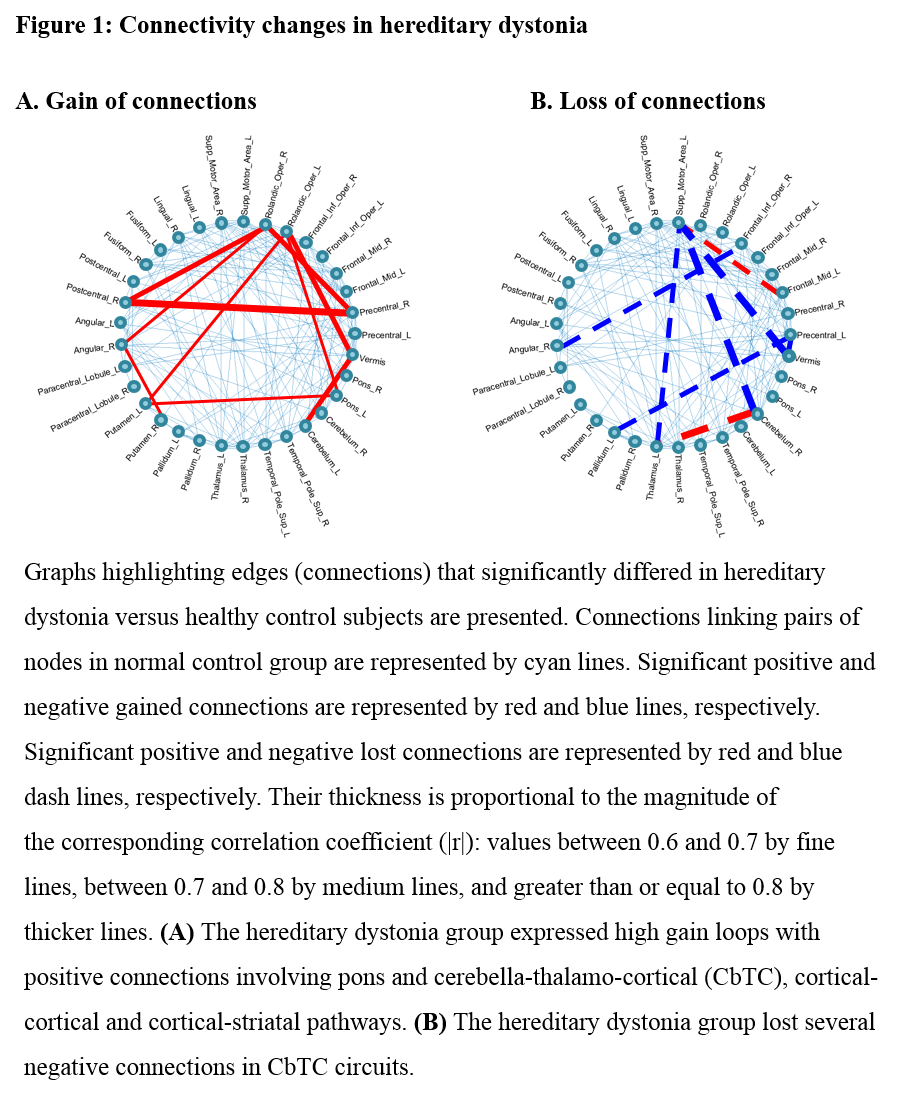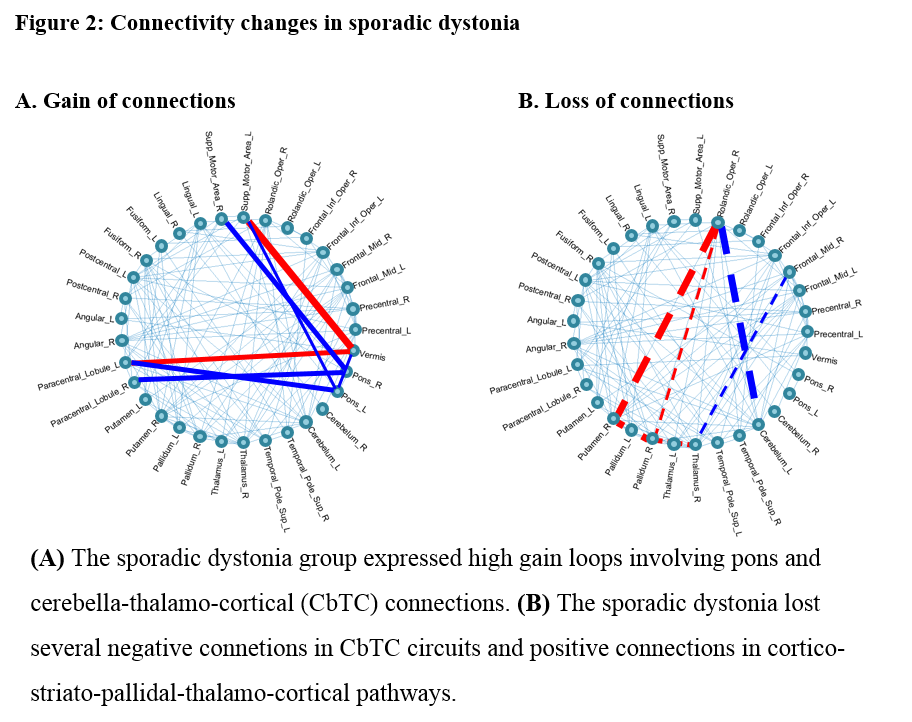Session Information
Date: Tuesday, September 24, 2019
Session Title: Dystonia
Session Time: 1:45pm-3:15pm
Location: Les Muses Terrace, Level 3
Objective: The objective of this study is to explore the changes in connectivity within the dystonia-related network space in hereditary and sporadic dystonia groups using graph theory [1-2] and resting state functional MRI (rs-fMRI).
Background: Neuroimaging techniques have advanced our understanding of the network abnormalities that underlie signs and symptoms of dystonia [3-4]. We have developed a method that uses independent component analysis to identify disease-related network in rs-fMRI [5-6]. Recently, we have applied the graph theory to imaging data to investigate the network architecture in disease [1-2,7]. However, it has not been addressed how interactions among key nodes of dystonia-related network are altered in hereditary (DYT1/DYT6) and sporadic dystonia patients.
Method: We studied 22 subjects with primary dystonia (10 hereditary dystonia and 12 sporadic dystonia) and 22 healthy control subjects. All subjects underwent rs-fMRI imaging on a 3T GE MRI scanner. We identified dystonia-related pattern (DytRP) according to the procedures in [5]. We next used graph theory method [1-2] to examine how the functional connections between individual DytRP network nodes are altered in dystonia groups.
Results: We constructed a subgraph composed of 528 edges based on the 33 DytRP nodes. Of these, 20-21 significant nodal connections changed in hereditary and sporadic dystonia groups. Both dystonia groups expressed high gain loops with positive feedback involving pons and cerebella-thalamo-cortical (CbTC) connections [Figure 1A-2A], while they lost several inhibitory (negative feedback) CbTC circuits [Figure 1B-2B]. The hereditary dystonia exhibited high gain cortical-cortical feedback loops [Figure 1A] with increased cortical-striatal excitatory (positive feedback) activity [Figure 1A]. However the sporadic dystonia reduced excitatory activity in cortico-striato-pallidal-thalamo-cortical pathways [Figure 2B].
Conclusion: Graph theory revealed connectivity changes in the dystonia groups. Hereditary dystonia was characterized by significant increases in positive connections in cortical-cortical and cortical-striatal projections relative to healthy controls. Both dystonia groups gained positive connections involving pons and CbTC circuits. Significant inhibitory cerebella-thalamo-cortical connectivity was seen in healthy subjects but not in either group of dystonia. The findings are consistent with previous connectivity studies conducted in this disorder.
References: 1. Ko, J.H. (2018), ‘Network structure and function in Parkinson’s disease’, Cereb Cortex; vol. 28, no. 12, pp. 4121-4135. 2. Niethammer, M. (2018), ‘Gene therapy reduces Parkinson’s disease symptoms by reorganizing functional brain connectivity’, Sci Transl Med, vol.10, no. 469. 3. Lerner, R.P. (2013), ‘Understanding the anatomy of dystonia: determinants of penetrance and phenotype’, Curr Neurol Neurosci Rep, vol.13, no. 11, pp. 401. 4. Fujita, K. (2017), ‘Imbalance of the direct and indirect pathways in focal dystonia: a balanced view’, Brain, vol. 140, no. 12, pp. 3075-3077. 5. Vo, A. (2017), ‘Parkinson’s disease-related network topographies characterized with resting state functional MRI’, Hum Brain Mapp, vol. 38, no. 2, pp. 617-630. 6. Fujita, K. (2016), ‘Brain networks revealed by resting state functional MRI in familial and sporadic primary dystonia’ [abstract], Movement Disorders, vol. 31, no. suppl 2. 7. Vo, A. (2018), ‘Three-dimensional network architecture of dystonia in resting state functional MRI’ [abstract], The 2018 OHBM Annual Meeting, Singapore. June 17-21.
To cite this abstract in AMA style:
A. Vo, N. Nguyen, K. Schindlbeck, D. Eidelberg. Resting state functional connectivity changes in dystonia [abstract]. Mov Disord. 2019; 34 (suppl 2). https://www.mdsabstracts.org/abstract/resting-state-functional-connectivity-changes-in-dystonia/. Accessed April 1, 2025.« Back to 2019 International Congress
MDS Abstracts - https://www.mdsabstracts.org/abstract/resting-state-functional-connectivity-changes-in-dystonia/


